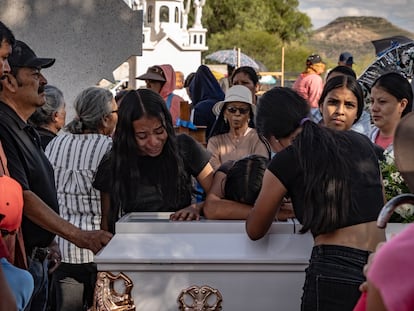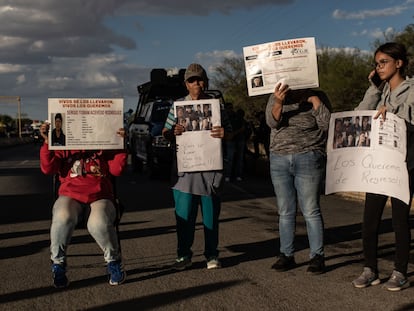Narcoterror in Zacatecas, Mexico: How a group of teens was kidnapped and killed with impunity
The brutal murders in the community of Malpaso, in the north-central state, underscore how drug cartels control large swathes of the country
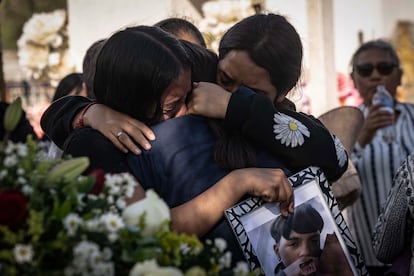

In the Mexican state of Zacatecas, everyone is sleeping. It’s late at night – seven teenagers are resting in two rooms at El Potrerito ranch. It’s not an unusual scene: the farm, a gray cinder block building on the outskirts of the community of Malpaso, often hosts sleepovers.
The owners of the property are the parents of Héctor Alejandro Saucedo. He and his friends always used to spend their free time at the ranch, watching movies, staring at the ceiling, talking about life, having lunadas — overnight parties. The things you do when you’re 18 years old and the most important thing in the world is spending time with your friends. Héctor’s parents didn’t mind — the boys weren’t very rowdy, they never caused trouble for anyone.
Suddenly, at around four in the morning on Sunday, September 24, engine noises were heard behind the ranch, along the dried-up river, where a bed of dust and stones replaced water long ago. “There were about three cars,” a ranch worker recalls. He doesn’t want his name to be used. Like nearly everyone interviewed by EL PAÍS in this community, he is fearful of reprisals.
The noise was like an alarm — a warning that something bad was about to happen. A group of armed men descended from the vehicles. The hitmen shot into the sky. That’s when the nightmare began.
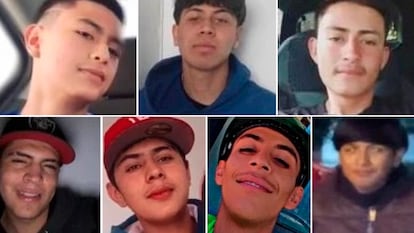
The attackers broke into the ranch. They opened the large metal gate that protects the residential area and walked across the patio, accessing the two rooms where the young people were sleeping. They forced them out of bed. They didn’t let them put their shoes on; some weren’t even allowed to wear a shirt. Drowsy and confused, the teens probably still didn’t understand what was going on.
Minutes later, the seven young people were placed inside some cars. The skid marks show that the vehicles took a sharp turn just a few feet from the ranch. Maybe the drivers took a wrong turn — or maybe they suddenly changed their minds. The tracks can still be seen a week later, on the soil of the farm’s cactus orchard, near the pig pens, the chicken coop and the stables. The kidnappers and their victims disappeared among the trees and the darkness.
An eternal war
Today, the rooms are just as the boys left them. There are mattresses on the floor, a double bed and a bunk bed. The green and red walls are scuffed, there are piles of clothes, an empty beer bottle, binders, used deodorants, a straw hat and an image of Jesus presiding over everything. In the inner courtyard, the motorcycles that belonged to two of the teenagers are still parked. The worldly properties that prove that there once was life in this place.
Everyone in the community heard the noise made by the abduction, the shots fired in the night sky. Everyone, that is, except the people who should have heard it. There is a police station not 200 meters from the ranch, on the road from Zacatecas to Guadalajara. But nobody came to stop the attack.
In a news conference a week after the kidnappings, the authorities claimed that they received an alert just after five in the morning and that it took them 15 minutes to send four patrol cars. The mothers and fathers of the teenagers vehemently disagree: no officer appeared at El Potrerito until several hours later. Only one showed up, and he was unarmed. “They sent a police officer after eight in the morning… he had no weapon, no vest, nothing. All the residents around the houses heard the gunshots – it cannot be possible that [the police] didn’t hear them,” a father protests.
Of course, shots aren’t too surprising in Malpaso. Across the town, the Jalisco New Generation Cartel (CJNG) has long reigned, waging an eternal war against the Sinaloa Cartel. There’s a curfew in place: when night falls, not a soul can be seen on the streets. “They’ve been [shooting bullets at each other] for six years,” a ranch worker sighs.

Child soldiers
Late Sunday morning, the news began to spread throughout the community. Relatives reported the kidnapping to the State Prosecutor’s Office. The authorities assured the families that they had begun the search. However, it is suggested that it took days for any action to happen. Families had to block the roads in protest for the agents to really mobilize.
By Monday, security forces began searching Malpaso and the surrounding communities. They found two vehicles that seemed to be related to the case. Inside, there was an automatic rifle, 282 rounds of ammunition, 13 magazines, three marijuana cigarettes and seven glass vials. But no trace of the teenagers.
That same day, in the municipality of Jerez, located 25 minutes from El Potrerito ranch, the police intercepted another car. Two teenagers ages 15 and 16, originally from Durango, were detained. They were carrying an arsenal: five guns, 2,427 cartridges, 57 magazines and four homemade bombs. During the interrogation, the agents realized that the two detainees were members of the armed group that had abducted the teens. They are still in the custody of Mexico’s Attorney General’s Office.
Tuesday came without much glimmer of hope. Tired of the lack of progress, the boys’ relatives desperately blocked the Zacatecas-Guadalajara highway for nine hours, at the same checkpoint near the ranch. Meanwhile, 50 miles away, in the town of Genaro Codina, a truck with two people tied up inside tried to escape the authorities. The kidnappers in the cabin opened fire on the police, but the agents still managed to stop them. They didn’t know it yet, but they were about to find the definitive clue that would lead to the whereabouts of the seven teenagers.
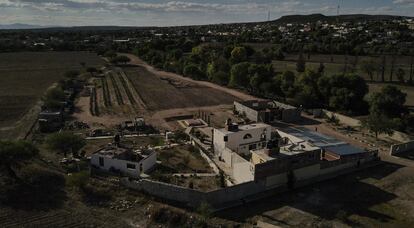
“They were full of life”
The authorities questioned the two young people who had been tied up. They said that they had just been with seven other boys who were also kidnapped; that both they and the teenagers from Malpaso sell drugs for the CJNG. This information has still not been confirmed. However, their testimony was important: it allowed officers to find the location of the kidnapped boys.
That same day, in another operation, the military detained three men and a woman who were armed to the teeth in the city of Villanueva. It was found that they were also involved in the kidnapping. In total, six people have already been arrested in connection with the case. In another confrontation, two more hitmen were arrested, although apparently they have no direct relationship to the Malpaso crime. Meanwhile, the relatives of the seven kidnapped youths began to receive videos in which their barefoot children could be seen walking through the mountains, being shoved and tortured. Anger and despair filled their bones.
On Wednesday, a helicopter from the Zacatecas Public Security Secretariat flew over the mountains where the two bound young men last saw the seven teenagers. It’s a wild and steep area, difficult to access. A piece of good news reached the human barricade that the mothers and fathers had formed on the road: the search team had found one of the boys alive. But, shortly afterwards, reality prevailed and destroyed any further trace of hope: Sergio Yobani Acevedo Rodríguez, 18, was the only survivor. The bodies of the rest of the boys were found about 250 feet away from him. They were only three miles from the ranch.
The families spent the night in the Prosecutor’s Office, facing the worst possible fate for parents: identifying the bodies of their children. On Thursday morning, the wakes began. In Malpaso, the funeral for 15-year-old Óscar Ernesto Rojas Alvarado and 17-year-old Diego Rodríguez Vidales was the most crowded. The relatives of the other families preferred to mourn their dead in private.
Residents of Malpaso, meanwhile, gathered in the municipal hall to remember the children, who were “calm, normal,” well-behaved boys. The teens were motorcycle fanatics who loved to dance to banda music. “The kids were full of life, like any teenager. Healthy, very happy. At school, they were good students,” cries María Azucena Casillas, their former teacher.

A wind orchestra accompanied the funeral processions towards the church. In the cemetery, there was palpable anger and fear: there were “hawks” among the people, lookouts for the murderers. They tend to be present at funerals, so that nobody forgets who is in charge. Sent by the narcos, they have total immunity and are unwilling to grant a single day of peace to the residents, not even at the funeral for two children. Almost no one speaks to the press, wary of retaliation. Those who share their thoughts tend to do so on the condition of anonymity.
The autopsy results, released hours after the funerals, show that the young people died from heavy blows to the head. Contrary to the rumors that were spread by some of the townspeople, the report clearly indicates that there were no traces of drugs in the teenagers’ bodies. Sergio Yobani remains in hospital, guarded by police.
“He still wakes up saying: ‘Don’t hit me anymore, I haven’t done anything wrong.’ There are no words to explain to you the condition that they found him in,” a relative laments. Nearly everyone in Malpaso believes that Sergio Yobani’s life was spared so that he could be “a messenger” — the person in charge of spreading the cartel’s message of terror. The Prosecutor’s Office believes that the dispute over the area between the CJNG and the Sinaloa Cartel is the reason behind the murders.
After the funeral, the families are broken. As are the residents of Malpaso. They know that, when the press leaves, they will once again be left in the dark with the drug traffickers, despite the government’s unfulfilled promises of security. “After this, it will be hell,” one of the relatives predicts.
Everyone knows that this isn’t the end. Despite the particularly bloody and gruesome nature of the case, the death of these boys is just part of a larger wave of violence, invisible to the eyes of the rest of the world.
The six teenagers who were abducted and killed in Malpaso:
Jorge Alberto René Ocón Acevedo, 14
Óscar Ernesto Rojas Alvarado, 15
Diego Rodríguez Vidales, 17
Héctor Alejandro Saucedo Acevedo, 17
Gumaro Santacruz Carrillo, 18
Jesús Manuel Rodríguez Robles, 18
Sign up for our weekly newsletter to get more English-language news coverage from EL PAÍS USA Edition
Tu suscripción se está usando en otro dispositivo
¿Quieres añadir otro usuario a tu suscripción?
Si continúas leyendo en este dispositivo, no se podrá leer en el otro.
FlechaTu suscripción se está usando en otro dispositivo y solo puedes acceder a EL PAÍS desde un dispositivo a la vez.
Si quieres compartir tu cuenta, cambia tu suscripción a la modalidad Premium, así podrás añadir otro usuario. Cada uno accederá con su propia cuenta de email, lo que os permitirá personalizar vuestra experiencia en EL PAÍS.
¿Tienes una suscripción de empresa? Accede aquí para contratar más cuentas.
En el caso de no saber quién está usando tu cuenta, te recomendamos cambiar tu contraseña aquí.
Si decides continuar compartiendo tu cuenta, este mensaje se mostrará en tu dispositivo y en el de la otra persona que está usando tu cuenta de forma indefinida, afectando a tu experiencia de lectura. Puedes consultar aquí los términos y condiciones de la suscripción digital.
More information
Archived In
Últimas noticias
Most viewed
- Reinhard Genzel, Nobel laureate in physics: ‘One-minute videos will never give you the truth’
- Oona Chaplin: ‘I told James Cameron that I was living in a treehouse and starting a permaculture project with a friend’
- Pablo Escobar’s hippos: A serious environmental problem, 40 years on
- Why we lost the habit of sleeping in two segments and how that changed our sense of time
- Chevy Chase, the beloved comedian who was a monster off camera: ‘Not everyone hated him, just the people who’ve worked with him’
